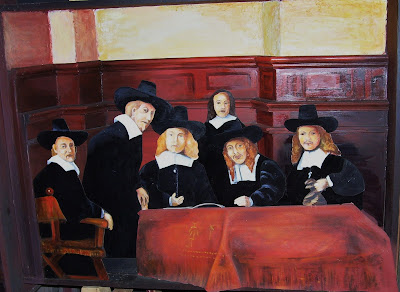We have a big red barn in our yard which I use as a studio and workplace. As I worked on dioramas and paintings I realized that I had a great oportunity to recreated the Sistine Ceiling Frescos by Michelangelo. This photo is a long shot of a portion of the barn ceiling. Each of the paintings will be described as we go along.
The next one is called "God Creates the Sun and the Moon". Notice, he is now wearing his customary pink nighty. On the right you can see David and Goliath which is shown in the next photo.
Everyone knows about David and his sling shot but we tend to forget that David had no qualms about beheading Goliath.
In the next photo we see Isaiah and next to him is a Lunette which shows three ancestors of Jesus. On each side of the Lunette Michelangelo painted his “Orange Male Nudes”. Why? We are not sure. Many nude males are painted all over the ceiling.
The first one I have named "And then, He Created Speedo Briefs".
Michelangelo’s sense of humor often goes unnoticed. He was the master painter of the muscular male body; however, he always gave these robust fellows small infantile genitals. Was this an expression of modesty or some kind of joke? Whatever the answer is, when I painted The Creation of Adam I attempted to take his “joke” one step further. Also this may be the only recreation of this painting in which God is not wearing his pink outfit and we get to see God’s abs. Of course those pesky little cherubs are still riding around in God's Sky Wagon.
The next one is called "God Creates the Sun and the Moon". Notice, he is now wearing his customary pink nighty. On the right you can see David and Goliath which is shown in the next photo.
Here we see the Delphic Sibyl surrounded by cherubs and more“Orange Nudes”.
Next we are looking down the ceiling toward the "Day of Judgement" and we see more “Orange Nudes” and the Ancestors of Jesus. Some people have suggested that the bearded man shown in the middle of the Ancestors Painting might be me. Next in line is the Delphic Sibyl.
Before we get to the Day of Judgement lets take a look at the "Beheading of Holofernes"
This painting shows in gruesome detail the head of Holofernes being carried by Judith’s maid while the limbs of the decapitated body are threshing around in the next room.
THE DAY OF JUDGEMENT
Although my painting is fairly large (8 X 10 ft) it is not nearly large enough to include all of the bodies and interactions taking place in Michelangelo’s original fresco. My version uses sections of the original to make a painting which summarizes some of the action and intent. In the upper portion of the painting St. Bartholomew is holding a knife in one hand and his flayed skin in the other. Rather than paint St. Bartholomew’s face on the skin Michelangelo painted his own face, and I for the sake of consistency have done likewise.









































